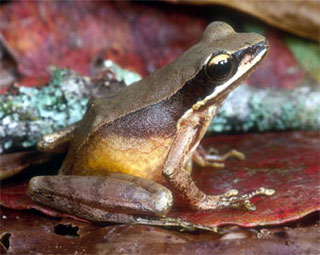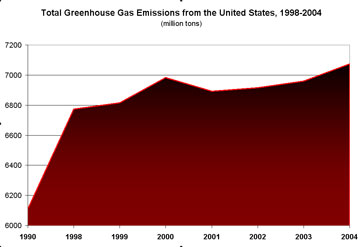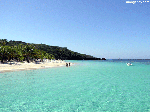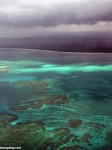April 26, 2006
A new series of mongabay.com and wildmadagascar.org t-shirts is now available. Added to the popular "Wildlife of Madagascar" line, are some silly nature and non-nature shirts including: "Licking this frog may make you crazy", "In Madagascar there is a lemur that dances", "My other car is a hallucinogenic tree frog", "Making friends", and more. Be the first on your block to have one.
Petrobras, the national oil company of Brazil, canceled plans to build an access road into Yasuni National Park in the rainforest of the Ecuadorian Amazon. The firm had been under pressure from environmentalists and the new government of Ecuador, which the company had attempted to bully with a lawsuit that was eventually rejected in court. Despite the apparent victory on the road issue, conservation groups are still concerned over oil development in the region.
A new study published in Nature says some coral are able to survive bleaching events by gorging themselves. An experiment with Hawaiian corals showed that when bleached, one species sharply increased its intake of food, increasing the likelihood that it would survive elevated water temperatures. The study has broader implications for the health of coral reefs worldwide, suggesting that any coral may recover from bleaching if it can ramp up feeding. This finding is important given predictions that bleaching events are going to become increasingly frequent and severe as the world's oceans warm.
Plants that could help treat or cure diseases such as cancer, AIDS and malaria have been found in the forests of the heart of Borneo, according to a new WWF report. But the global conservation organization says this medical treasure trove is threatened and calls for its long-term protection. The report reveals that scientists are currently testing samples collected in the Malaysian states of Sabah and Sarawak, as well as in Kalimantan, the Indonesian part of Borneo. They hope to develop drugs that could contribute to the treatment of major, deadly human diseases.
I will be traveling so there may be no updates for a few days.
April 25, 2006
Recently much has been made about the conversion of Asia's biodiverse rainforests for oil-palm cultivation. Environmental organizations have warned that by eating foods that use palm oil as an ingredient, Western consumers are directly fueling the destruction of orangutan habitat and sensitive ecosystems. So, why is it that oil-palm plantations now cover millions of hectares across Malaysia, Indonesia, and Thailand? Why has oil palm become the world's number one fruit crop, trouncing its nearest competitor, the humble banana? The answer lies in the crop's unparalleled productivity. Simply put, oil palm is the most productive oil seed in the world. A single hectare of oil palm may yield 5,000 kilograms of crude oil, or nearly 6,000 liters of crude. For comparison, soybeans and corn--crops often heralded as top biofuel sources--generate only 446 and 172 liters per hectare, respectively. Further, as a biofuel, palm oil is cost competitive with $70 oil--it currently fetches about $54 a barrel.
My apologies for the performance of the site over the past couple of days--I am having serious network problems.
April 24, 2006
Tonight six grassroots environmentalists will be awarded the prestigious Goldman Environmental Prize. This year's winners include a Vietnam veteran fighting Pentagon plans to incinerate chemical weapons stockpiles, a man who tipped the United Nations to illegal logging in war-torn Liberia, the person behind the creation of the world's largest area of protected tropical rainforest, a lawyer in Ukraine who helped block the construction of canal that would have cut through the heart of the Danube Delta, a woman who won restitution for indigenous land owners from logging interests in Papua New Guinea, and a researcher who pushed social impact assessments for major dam developments in China.
April 23, 2006
In an April 21st, 2006 editorial published in the Canada Free Press Dennis T. Avery, senior fellow for Hudson Institute in Washington, DC and the Director for Global Food Issues, called Brazil's cerrado ecosystem a "wasteland" and criticized a recent report from the environmental activist group Greenpeace that linked Amazon deforestation to soy-based animal feed used by fast-food chains in Europe. In his haste to find fault with the report, Mr. Avery seemed to have skipped over some details in the document, appearing to be more intent on promoting his past work on the use of petroleum-based pesticides and fertilizers than focusing on the evidence actually presented by the environmental group. Further, few biologists would agree with his characterization of the biologically-rich cerrado as a wasteland.
April 22, 2006
A note about Earth Day, written last year: So today is Earth Day. You may look at Earth Day as another useless "holiday" that appears on your calendar, yet does not warrant an actual vacation day, where people parade around about trees or not driving, CEOs stand up to talk about their environmental stewardship as a PR strategy and Hallmark, ironically, sells more cards. Another gimmick day full of false promises and empty pledges to make real environmentally-motivated change, while everything remains regretfully the same.
Yesterday Apple announced an expanded version of its recycling program, offering computer take-back and recycling with the purchase of a new Macintosh system beginning in June.
April 21, 2006
Six species of frogs have been discovered in the Southeast Asia nation of Lao PDR, according to the Bronx Zoo-based Wildlife Conservation Society (WCS). Three newly discovered frog species are described in the recent issue of Copeia, the journal of the American Society of Herpetologists and Ichthyologists. WCS says that little is known about the new frogs, other than the location they were found and how the compare morphologically to similar species. The discoveries come as amphibian populations are in decline worldwide. A study released earlier this year suggests that climate change is directly responsible for worsening infections caused by a skin fungus. This infectious disease -- a type of chytrid fungus (Batrachochytrium dendrobatidis)--is now found in frog populations around the world and is the main suspect in the rapid disappearance of amphibians.
Cellulose -- a fibrous molecule found in all plants -- is the most abundant biological material on Earth. It is also a favored target of renewable, plant-based biofuels research. Despite overwhelming interest, scientists know relatively little about how plant cells synthesize individual cellulose fibers. Now, work from the Carnegie Institution's Department of Plant Biology and Stanford University describes the first real-time observations of cellulose fiber formation.
April 20, 2006
A new study published in Nature says that climate change will be more moderate than some recent projections. The research, based on proxy data from the past 700 years -- including carbon dioxide levels measured in sea ice, temperature data derived from tree rings, and the cooling impact of volcanic eruptions -- suggests that climate sensitivity is likely to be in the moderate range of current projections. The paper indicates a 90 percent probability that a doubling of carbon dioxide levels will result in temperature increases of between 1.5 and 6.2 degrees and only a 5 percent chance that global temperatures will climb more than 6°C (10.8°F).
April 19, 2006
Figures released quietly Monday show that US greenhouse gas emissions hit a record in 2004, rising 1.7 percent over 2003. The increase, equivalent to a rise of 115 million tons of carbon dioxide, was the largest annual increase since 2000. In total, the United States released the equivalent of nearly 6,300 million tons of carbon dioxide into the atmosphere. America is the world's largest polluter in terms of greenhouse gas emissions. US emissions have risen by 15.8 percent from 1990 to 2004.
April 18, 2006
The "photos by topic" section of the site has been updated here.
April 17, 2006
Children born in six African countries can expect to die before their 41st birthday while kids born in 16 countries can expect to live past 80 according to an annual report released by the UN's World Health Organization. The report, "World Health Report 2006 - Working together for health", released earlier this month reveals a widening quality of life between the world's poorest and richest people. The report also reveals slowing world population growth.
April 16, 2006
The revised rainforest section of mongabay.com is officially ready and available at rainforests.mongabay.com. The revised site includes environmental profiles and deforestation statistics for more than 60 countries, and features thousands of rainforest wildlife photos from around the world. Additionally, the site includes a section geared towards children, with learning activities and educational resources for teachers. "Mongabay.com is dedicated to providing necessary communication to those interested in the fate of our rainforests," Ira Rubinoff, director of the Smithsonian Tropical Research Institute (STRI), said. "It has a scientific base that should provide reliable information to all who share an interest in the future quality of life on this planet." An associated press release is available here.
April 15, 2006
Parts of the Caribbean and Central America are likely to experience drier summers by 2050 according to research presented by UCLA atmospheric scientists in the April 18 issue of Proceedings of the National Academy of Sciences (PNAS). Analyzing 10 global climate computer simulations from various agencies, the researchers found that the majority of the computer models predict a substantial decrease in tropical rainfall to occur by mid-century. By the end of this century, the models show that summer rainfall could decline by 20 percent or more in parts of the Caribbean and Central America.
A process for converting coal into diesel could reduce foreign dependence on oil while offering a cleaner-burning alternative fuel say researchers from the University of North Carolina at Chapel Hill and Rutgers, the State University of New Jersey.
Lizards have given Johns Hopkins researchers a tantalizing clue to the evolutionary origins of light-sensing cells in people and other species. The lizard study describes how the lizard's so-called third, or parietal, eye, distinguishes two different colors, blue and green, possibly to tell the time of day. Specialized nerve cells in that eye, which looks more like a spot on the lizard's forehead, use two types of molecular signals to sense light: those found only in simpler animals, like scallops, and those found only in more complex animals like humans.
April 14, 2006
A new study warns that walrus calves are being stranded by melting sea ice in the Arctic Ocean. Researchers aboard a U.S. Coast Guard icebreaker found lone walrus calves swimming far from shore--something never before documented. The sightings suggest that increased polar warming may be forcing mothers to abandon their pups as they follow the rapidly retreating ice northwards. If these observations portray a larger trend, a warmer Arctic may lead to decreases in the walrus population say the scientists whose research was published in the April issue of Aquatic Mammals. The walrus warning comes as concerns mount over the impact of climate change on Arctic wildlife populations. In February, the U.S. Fish and Wildlife Service today announced that it was considering a petition to list the polar bear as threatened under the Endangered Species Act due to the effects of global warming, specifically receding ice and rising temperatures.
April 13, 2006
A new rainforest conservation initiative by developing nations offers great promise to help slow tropical deforestation rates says William Laurance, a leading rainforest biologist from the Smithsonian Tropical Research Institute in Panama, in an article appearing Friday in New Scientist. Laurance, who is also president of the Association for Tropical Biology and Conservation, says the proposal "basically involves selling or renting rainforests to help protect the billions of tons of carbon they store, thereby slowing the rapid buildup of carbon dioxide and other greenhouse gases in the atmosphere."
The most cost-effective way to stop non-native rats and mongoose from decimating highly endangered species on larger tropical islands is not by intensive trapping, but instead by preserving the forest blocks where wildlife live, according to a study by the Bronx Zoo-based Wildlife Conservation Society and other groups.
April 12, 2006
According to The Wall Street Journal automakers and oil companies are bickering over who is to blame for high oil prices. In an unusually public exchange, Jason Vines, vice president of communications for DaimlerChrysler's U.S. arm criticized Exxon Mobil Corp, the world's most profitable company, in a blunt blog posting.
Brazilian environmental authorities closed down an illegal logging operation in the Amazon according to a report from the Associated Press. An agent with Ipaam, the environmental authority of Amazonas state, told Michael Astor of the Associated Press that the Norte Wood logging company was operating without a license in town of Novo Aripuana. The agency made one arrest and seized 500 cubic meters of wood in the raid.
Rising nitrogen emissions from human activities -- such as fossil fuel burning and livestock farming -- may soon threaten plant species in some of the world's most biodiverse places according to British researchers.
The Earth could see massive waves of species extinctions around the world if global warming continues unabated, according to a new study published in the scientific journal Conservation Biology.
Part III of the Wilderness Classroom's Expedition to the Amazon: Rivers are the highways of the Amazon. Instead of driving cars and trucks, people use use boats to travel from place to place. Launchas are large boats powered by strong engines that travel up and down all the major rivers in the Amazon Basin. We have spent the last two day nights and two night on a launcha that is traveling up the Amazon River at about 10 miles an hour.
April 11, 2006
After experiencing one of the most devastating coral bleaching events on record during September and October of 2005, reefs in the Caribbean are under attack from deadly diseases according to Reuters. Bleaching events--caused by high water temperatures--leave coral more susceptible to infection and scientists are concerned that global warming could contribute the ever greater reef die-offs in the future.
Palo Alto, California has the highest percentage of renewable energy users in the country according to the National Renewable Energy Laboratory (NREL) 2005 Top Ten list.
Researchers from Brown University have reconstructed 5-million years of climate using tiny marine fossils found in mud off the coast of South America. The climate record unearthed by the Brown team is the longest continuous record of ocean temperatures on Earth.
April 10, 2006
Hundreds of fires are burning across Central America according to NASA satellite images and local reports. Fires have been detected in Mexico, Guatemala, El Salvador, Honduras, and Nicaragua.
April 9, 2006
Part 2 of the Wilderness Classroom Organization's expedition in the Peruvian Amazon: Belen is on the edge of the large city of Iquitos. Belen is unique because much of the city is covered in water for most of the year. From January to May the streets, soccer fields, and gardens are underwater. Many of the houses are built on rafts that float up and down as the river rises and falls. The floating city was full of life: people paddling canoes, children swimming and laughing, people going about their daily lives in houses floating on the Amazon River.
April 7, 2006
As human population growth rates diminish in coming years deforestation rates are expected to slow according to research published in Biotropica online. The report offers hope that reduced rates of forest conversion can stave off a future extinction crisis in the tropics, where most of the world's biodiversity is found. Scientists estimate that as much as 50 percent of the planet's terrestrial biodiversity is found in tropical rainforests distributed around the world but the United Nations recently warned that the current rate of extinction is running 100 to 1,000 times the normal background rate.
After a year-long investigation, environmental group Greenpeace has accused McDonald's of contributing to deforestation in the Amazon. Greenpeace's report, published today, alleges that much of the soy-based animal feed used by fast-food chains to fatten chickens is derived from soybeans grown in the Amazon Basin of Brazil.
April 6, 2006
The United States and Indonesia today agreed to fight illegal logging in some of the world's most diverse rainforests. Indonesian Trade Minister Mari Elka Pangestu and Chief of the US Trade Office (USTR) Robert Portman said the two countries will coordinate efforts of protect Indonesia's forests which have been significantly degraded and destroyed by the illicit timber trade. While Indonesia houses the most extensive rainforest cover in all of Asia, its natural forest area is rapidly being reduced by logging--most of which is illegal. Between 1990 and 2005 the country lost more than 28 million hectares of forest, including 21.7 million hectares of virgin forest, according to data from the United Nations.
The newly discovered species of rodent found in a marketplace in Central Laos turns out to not be so new or so rare after all. The Laotian rock rat (Laonastes aenigmamus), as the long-whiskered and stubby-legged rodent is now known, is commonly hunted and eaten by local people according to a conservation scientist.
Paleontologists have discovered fossils of a species that provides the missing evolutionary link between fish and the first animals that walked out of water onto land about 375 million years ago. The newly found species, Tiktaalik roseae, has a skull, a neck, ribs and parts of the limbs that are similar to four-legged animals known as tetrapods, as well as fish-like features such as a primitive jaw, fins and scales.
Scientists from the University of Utah and the Utah Museum of Natural History have discovered the remains of a new bird-like, meat-eating dinosaur in southern Utah.
A new report evaluating air pollution trends at the nation's 100 largest electric power producers shows that emissions of sulfur dioxide and nitrogen oxides have fallen markedly in recent years, but carbon dioxide (CO2) emissions have increased. The difference? Sulfur dioxide and nitrogen oxides are regulated, while carbon dioxide emissions are not. As such, the report makes a case for regulation of C02 pollution.
April 5, 2006
The Wilderness Classroom is a non-profit organization that strives to engage, excite, and motivate students and teachers using an interactive technology-based learning model that draws upon peoples' innate curiosity and desire for exploration. Members of the Wilderness Classroom have embarked on an expedition to the rainforests of Peru and will be posting regular updates on their adventures. The first post: The Adventure Begins--Wilderness Classroom in Peru.
The United Nations refugee agency warned that Colombia's indigenous communities are facing a humanitarian emergency due to the country's ongoing civil conflict. The agency says the Nukak, a nomadic group that was unknown to the outside world until 1988, are at particular risk.
April 4, 2006
California plans to introduce legislation that will impose binding limiting on future greenhouse gas emissions. The state aims to cut current levels of emissions 10 percent by 2020, to bring pollution in line with 1990 levels.
A secret proposal by the Environmental Protection Agency would weaken nearly 100 toxic air pollution standards and allow industrial plants across the country to emit significantly greater amount of toxins, according to a draft rule obtained by the Natural Resources Defense Council.
Increasing amounts of atmospheric carbon dioxide, driven by the burning of fossil fuels, are dissolving into the oceans, causing them to become slightly more acidic. This change in seawater chemistry could harm deep-sea calcifying animals like corals.
April 3, 2006
Every year some 20 billion disposable diapers are dumped into landfills throughout the United States, generating approximately 3.5 million tons of waste which can take 500 years to biodegrade. Besides creating huge amounts of trash, most disposables are made from materials whitened with chlorine in a process that produces dangerous toxins such as dioxin, furans and other organic chlorines. Cloth diapers--often touted as environmentally superior to disposables--have drawbacks as well, requiring large amounts of water and pesticides, in addition to going through a similar bleaching process. So what's the ecologically responsible alternative? Well, it may come from the land down under. An Australian couple has developed a diaper that is not only biodegradable but serves as a benchmark for green design in that it gives more to the environment than it takes. "gDiapers", as the product is known, was recently awarded the prestigious "Cradle to Cradle Design Certification Award" from MBDC, a design consulting organization that stresses green design. The diaper is the first packaged consumer product to be so honored.
April 2, 2006
In the April 2006 issue of BioScience, John E. Losey of Cornell University and Mace Vaughan of the Xerces Society for Invertebrate Conservation estimate the value of ecological services provided by insects. Looking at just four services--dung burial, control of crop pests, pollination, and wildlife nutrition--Losey and Vaughan calculate that the annual value of insects in these roles is at least $57 billion in the United States.
I have updated the recommended book list to include works on the environment, green design, and tropical ecology from 24 leading authors.
April 1, 2006
The Pacific Ocean is getting warmer and more acidic, while the amount of oxygen is decreasing, due to increased absorption of atmospheric carbon dioxide say scientists from the National Oceanic and Atmospheric Administration's Pacific Marine Environmental Laboratory and the University of Washington. Researchers report that the pH of saltwater in the Pacific has dropped 0.025 units since the early 1990s and warn that oceans could become even more acidic by the end of the century given current atmospheric carbon dioxide levels. Ocean acidification is of great concern due to its potential impact on marine life.












